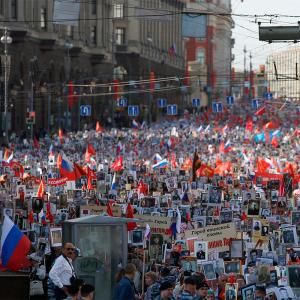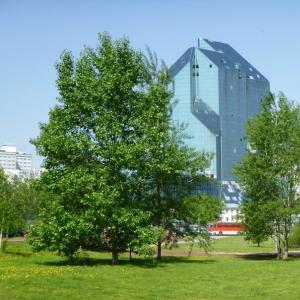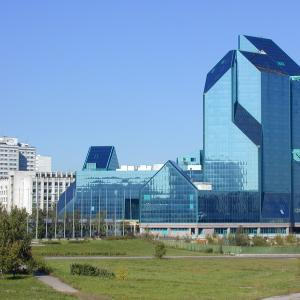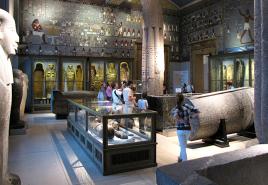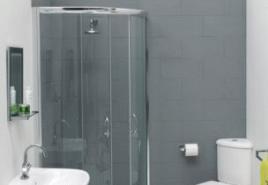Presentation in English about the life and scientific work of Maria Sklodowska-Curie entertaining facts about the English language (grade 7) on the topic. Presentation on the theme "Maria Sklodowska-Curie" Presentation on the theme of Pierre Curie
Ferromagnetism. Curie Point Didactic material for elective courses or physics lessons in grades 8, 11 with in-depth study of the subject.
Developers:
Zhdanov Vsevolod Nikolaevich, Tkach Olga Vyacheslavovna,
physics teacher MBOU secondary school № 12 of the city of Voronezh
Description of experimental work
Ferromagnet
- Ferromagnet - a substance that strongly interacts with a magnetic field. For example: iron, nickel
- Curie pointIs the temperature at which a ferromagnet loses its ferromagnetic properties. Each ferromagnet has its own Curie Point. For example: iron - 770 ° С nickel - 358 ° С
- On this topic, you can perform a complex and very beautiful experiment on the interaction of a small ferromagnetic body and an electromagnet with a gradual increase in temperature.
- The presentation contains a description and animation of the experiment
- Dielectric tripods - 2 pcs
- Electromagnet - 1 piece
- Candle - 1 piece
- Nichrome wire - 1 piece
- Thread - 1 m Tripods and electromagnet can be made by hand
- A piece of nichrome spiral suspended on a long thread attached to a tripod can be used as a ferromagnet. An electromagnet must be attached to the second tripod.
- The ferromagnet is attracted to the switched on electromagnet, performs a quarter of the oscillation, freezes in the extreme right position.
- A burning candle located under an electromagnet heats up the ferromagnet. Upon reaching the Curie Point, the nichrome wire loses its ferromagnetic properties and ceases to be attracted to the electromagnet.
- The body moves to a position of equilibrium and completes the first vibration.
- Then the ferromagnet cools down and is again attracted to the magnet.
- With a permanent magnet, the experiment is much worse, because as it heats up, the magnet loses its properties.
- A small ferromagnetic body must be carefully selected. Most of the "ferromagnetic" spirals from an electric stove, both purchased and unscrewed from old appliances, are not attracted to the magnet, as it turned out.
- Tripods must not be metal! Otherwise, a piece of the spiral quickly sticks to the tripod and does not even begin to oscillate.
This experiment was presented by the Voronezh team at the open Ural physics tournament in Yekaterinburg in 2012 as part of the Amazing Physics competition.
Can you do this experience?
Think:
- what equipment will you prepare?
- how do you build the installation?
- how much and what kind of hesitation will you get?
- Myakishev G.Ya., Bukhovtsev B.B., Charugin V.M. "Physics, grade 11, classic course" - a textbook for educational organizations; M .: "Education"
- Koshkin N.I., Shirkevich M.G. "Handbook of elementary physics" - M .: "Science", 1988
- https://pp.userapi.com/c416318/v416318552/a02/Atm1ijEu2K4.jpg
- Photo of the experimental setup https://pp.userapi.com/c416318/v416318552/a0b/ynzmTf5lDeY.jpg
Slide 2
Life, as you can see, is not easy for any of us. You have to believe that you are good for something, and this “something” needs to be achieved at all costs.
Maria Sklodowska-Curie, 1894
Slide 3
French physicist Maria Sklodowska-Curie was born on November 7, 1867 in Warsaw. She was the youngest of five children in the family of Vladislav and Bronislava Sklodowski. Maria was brought up in a family where science was respected. Her father taught physics at the gymnasium, and her mother, until she fell ill with tuberculosis, was the director of the gymnasium. Maria's mother died when the girl was eleven years old.
Slide 4
Maria studied brilliantly at school. Even at a young age, she felt the attractive power of science and worked as a laboratory assistant in her cousin's chemistry laboratory. The great Russian chemist Dmitry Ivanovich Mendeleev was a friend of her father. Seeing the girl at work in the laboratory, he predicted a great future for her if she continued her chemistry studies.
Slide 5
On the way to realizing Maria Sklodowska's dream of higher education, there were two obstacles: family poverty and the ban on admitting women to Warsaw University. Maria and her sister Bronya developed a plan: Maria will work as a governess for five years to enable her sister to graduate from medical school, after which Bronya must cover the costs of her sister's higher education. House in Warsaw where Maria Sklodowska-Curie was born
Slide 6
After leaving Poland in 1891, Maria entered the Faculty of Natural Sciences at the University of Paris (Sorbonne). In 1893, after completing the first course, Maria received a licentiate in physics from the Sorbonne (equivalent to a master's degree). A year later, she became a licentiate in mathematics.
Slide 7
In 1894, Maria met Pierre Curie at the house of a Polish émigré physicist. Pierre was the head of the laboratory at the Municipal School of Industrial Physics and Chemistry. By that time, he had carried out important research on the physics of crystals and the dependence of the magnetic properties of substances on temperature. Maria was researching the magnetization of steel.
Slide 8
Having approached at first on the basis of passion for physics, Marie and Pierre got married a year later. This happened shortly after Pierre defended his doctoral dissertation. Their daughter Irene was born in September 1897. Three months later, Maria completed her research on magnetism and began looking for a topic for a dissertation.
Slide 9
Marie Curie studies the phenomenon of radioactivity discovered in 1896 by Becquerel. She is interested in what is the source of continuous emission of rays and continuous, therefore, energy loss. She involves her husband in her research. The study of the new phenomenon was based on the technique used in the study of the phenomena of piezoelectricity discovered by Pierre Curie.
Slide 10
The researcher decides to dwell on this topic. But there is nowhere to do the work. After long troubles of Pierre Curie, Mary is taken away from the cold warehouse on the first floor of the institute, filled with rubbish. Without any amenities, without the necessary equipment and means, work begins at 6 degrees Celsius.
Slide 11
Soon the first result was obtained. It turns out that the radiation intensity is proportional to the amount of uranium in the samples and does not depend on the chemical compounds it enters into or on external conditions. It becomes clear that atoms are the source of the new radiation. But is it only uranium that has this property? Maria persistently searches among various minerals for the manifestation of the property of radioactivity.
Slide 12
She finds minerals that are much more radioactive than uranium and thorium and concludes that the radioactivity is due to the presence of new, previously unknown elements in the minerals.
Slide 13
The Curies are looking for new radioactive elements in uranium tar ore. They establish that natural uranium compounds contain two elements: one in the chemical processing of ore meets with bismuth, the other with barium. In July 1898, they find one of them. Maria calls it "polonium" after her native Poland. The following year they published in the Trudy Academy a report on the discovery of radium.
Slide 14
The properties of polonium and radium undermined the entire system of concepts of the structure of matter established in physics. Many scientists greeted the message of the new discovery with disbelief. It took four years to convince them. Finally, Sklodowska was able to obtain a pure radium salt and determine its atomic weight. Its method of obtaining pure radium salts is still used in industry.
Slide 15
In the years 1899-1900, Pierre and Maria established that the rays emitted by radium belong to three different categories: alpha, beta and gamma rays.
Slide 16
From 1900 to 1906, work was underway to isolate pure radium salts. Maria and Pierre make the discovery of the physiological effects of radium on the body. Industrial production of radium begins. Radium is being studied by the world's greatest scientists. In 1903, Pierre, Marie Curie and Henri Becquerel were awarded the Nobel Prize. Maria Sklodowska-Curie became the first woman to be awarded the Nobel Prize. Devi medals are also awarded by the Royal Society of London.
Slide 17
In 1906, having lived for 47 years, having barely received favorable conditions for scientific work, Pierre Curie dies in an accident on the street. In connection with the death of the great scientist, national mourning is declared.
Slide 18
After the death of her husband, Marie Curie continues research interrupted by the death of Pierre. She teaches at the Sorbonne and Sèvres. Maria creates and delivers the first and only course of lectures on radioactivity. She also edits and publishes The Proceedings of Pierre Curie. In 1906, Marie Curie was appointed professor at the Faculty of Natural Sciences at the Sorbonne - for the first time in the history of French higher education, a woman receives a professorship.
Slide 19
In 1911, Marie Curie is awarded the Nobel Prize in Chemistry. A great discovery, world fame, 2 Nobel prizes cause surprise in many contemporaries with the personality of Marie, and in many others an envious and hostile feeling. And an evil flurry suddenly swoops in on Marie, trying to destroy her.
Slide 20
In 1914, the Radium Institute was opened with two departments: a radioactive laboratory under the direction of Marie Curie and a laboratory for biological research and radiotherapy, where the prominent medical scientist Professor Claude Regaud organizes the study of cancer. With funds from the Women's Union of France, Maria creates the first "radiological vehicle". In an ordinary car, Maria places an X-ray machine and a dynamo. Which is driven by a car motor and provides the required current. Since August 1914, this mobile station has been circling hospital after hospital. During the period from 1914 to 1918, Marie Curie created 200 mobile and permanent X-ray units.
Slide 21
From 1919 to 1934, Marie Curie continued her research at the Radium Institute. She triumphantly visits abroad, is actively involved in social activities, participates in the creation of the Radium Institute in Warsaw.
Slide 22
Researchers from different countries worked in the Sklodowska-Curie laboratory. M. Curie's personal funds turned out to be negligible, since she invested her Nobel Prize in war loans. For systematic scientific work at the Radium Institute, pure radium was needed, which became the most precious element in the world. Curie donated her own gram of radium to medicine during the war. Despite the difficulties, regardless of health, she continued her scientific research.
Slide 26
Maria Sklodowska-Curie (20,000 gold, Poland) Poland 10 zloty, 1967. Maria Sklodowska-Curie Boguslav Sidorovich opened a restaurant and decided to name it "Polonium" in honor of the metal opened by his compatriot Maria Sklodowska-Curie
View all slides
Slide 1

Slide 2
Life, as you can see, is not easy for any of us. You have to believe that you are good for something, and this “something” needs to be achieved at all costs.
Maria Sklodowska-Curie, 1894

Slide 3
French physicist Maria Sklodowska-Curie was born on November 7, 1867 in Warsaw. She was the youngest of five children in the family of Vladislav and Bronislava Sklodowski. Maria was brought up in a family where science was respected. Her father taught physics at the gymnasium, and her mother, until she fell ill with tuberculosis, was the director of the gymnasium. Maria's mother died when the girl was eleven years old.

Slide 4
Maria studied brilliantly at school. Even at a young age, she felt the attractive power of science and worked as a laboratory assistant in her cousin's chemistry laboratory. The great Russian chemist Dmitry Ivanovich Mendeleev was a friend of her father. Seeing the girl at work in the laboratory, he predicted a great future for her if she continued her chemistry studies.

Slide 5
On the way to the realization of Maria Skłodowska's dream of higher education, there were two obstacles: the poverty of the family and the ban on the admission of women to the University of Warsaw. Maria and her sister Bronya have developed a plan: Maria will work as a governess for five years in order to enable her sister to graduate from medical school, after which Bronya must cover the costs of her sister's higher education.
House in Warsaw where Maria Skłodowska-Curie was born

Slide 6

Slide 7
In 1894, Maria met Pierre Curie at the house of a Polish émigré physicist. Pierre was the head of the laboratory at the Municipal School of Industrial Physics and Chemistry. By that time, he had carried out important research on the physics of crystals and the dependence of the magnetic properties of substances on temperature. Maria was researching the magnetization of steel.

Slide 8
Having approached at first on the basis of passion for physics, Marie and Pierre got married a year later. This happened shortly after Pierre defended his doctoral dissertation. Their daughter Irene was born in September 1897. Three months later, Maria completed her research on magnetism and began looking for a topic for a dissertation.

Slide 9
Marie Curie studies the phenomenon of radioactivity discovered in 1896 by Becquerel. She is interested in what is the source of continuous emission of rays and continuous, therefore, energy loss. She involves her husband in her research. The study of the new phenomenon was based on the technique used in the study of the phenomena of piezoelectricity discovered by Pierre Curie.

Slide 10

Slide 11
Soon the first result was obtained. It turns out that the radiation intensity is proportional to the amount of uranium in the samples and does not depend on the chemical compounds it enters into or on external conditions. It becomes clear that atoms are the source of the new radiation. But is it only uranium that has this property? Maria persistently searches among various minerals for the manifestation of the property of radioactivity.

Slide 12

Slide 13
The Curies are looking for new radioactive elements in uranium tar ore. They establish that natural uranium compounds contain two elements: one in the chemical processing of ore meets with bismuth, the other with barium. In July 1898, they find one of them. Maria calls it "polonium" after her native Poland. The following year, they published in the Trudy Academy a report on the discovery of radium.

Slide 14
The properties of polonium and radium undermined the entire system of concepts of the structure of matter established in physics. Many scientists greeted the message of the new discovery with disbelief. It took four years to convince them. Finally, Sklodowska was able to obtain a pure radium salt and determine its atomic weight. Its method of obtaining pure radium salts is still used in industry.

Slide 15

Slide 16
From 1900 to 1906, work was underway to isolate pure radium salts. Maria and Pierre make the discovery of the physiological effects of radium on the body. Industrial production of radium begins. Radium is being studied by the world's greatest scientists.
In 1903, Pierre, Marie Curie and Henri Becquerel were awarded the Nobel Prize. Maria Sklodowska-Curie became the first woman to be awarded the Nobel Prize. Devi medals are also awarded by the Royal Society of London.

Slide 17

Slide 18
After the death of her husband, Marie Curie continues research interrupted by the death of Pierre. She teaches at the Sorbonne and Sèvres. Maria creates and delivers the first and only course of lectures on radioactivity. She also edits and publishes The Proceedings of Pierre Curie. In 1906, Marie Curie was appointed professor at the Faculty of Natural Sciences at the Sorbonne - for the first time in the history of French higher education, a woman receives a professorship.

Slide 19

Slide 20
In 1914, the Radium Institute was opened with two departments: a radioactive laboratory under the direction of Marie Curie and a laboratory for biological research and radiotherapy, where the prominent medical scientist Professor Claude Regaud organizes the study of cancer. With funds from the Women's Union of France, Maria creates the first "radiological vehicle". In an ordinary car, Maria places an X-ray machine and a dynamo. Which is driven by a car motor and provides the required current. Since August 1914, this mobile station has been circling hospital after hospital. During the period from 1914 to 1918, Marie Curie created 200 mobile and permanent X-ray units.

Slide 22
Researchers from different countries worked in the Sklodowska-Curie laboratory. M. Curie's personal funds turned out to be negligible, since she invested her Nobel Prize in war loans. For systematic scientific work at the Radium Institute, pure radium was needed, which became the most precious element in the world.
Curie donated her own gram of radium to medicine during the war. Despite the difficulties, regardless of health, she continued her scientific research.

Slide 25
Monument to Maria Skladowska-Curie in Krakow.

Slide 26
Maria Sklodowska-Curie (20,000 gold, Poland)
Poland 10 zloty, 1967. Maria Sklodowska-Curie
Boguslav Sidorovich opened a restaurant and decided to name it "Polonium" in honor of the metal opened by his compatriot Maria Sklodowska-Curie
Maria Sklodowska - Curie () The work was carried out by pupils of the 8 "A" class of the MOU "SOSH 21" Parkhomenko Victoria Kolesova Daria
“In those distant years, at the dawn of the atomic age, the discoverers of radium did not know about the effect of radiation. Radioactive dust drifted into their laboratory. The experimenters themselves calmly took the drugs with their hands, kept them in their pockets, unaware of the mortal danger "M. P. Shaskolskaya

French physicist and chemist, Polish by origin, one of the founders of the theory of radioactivity. Together with her husband, Pierre Curie, she discovered new radioactive elements. She established the effect of radiation on a living cell, was the first to use radioactivity in medicine. Maria Sklodowska - Curie ()

Maria Sklodowska-Curie, the only woman physicist - twice Nobel laureate, a legendary man who remains to this day a unique example in the history of world science. She was the fifth child, and became a common favorite in a large and friendly family. The girl's abilities manifested themselves early - at four years old she independently learned to read; at the boarding school, and then at the gymnasium - she was the best student. Maria Sklodowska was born on November 7, 1867 in Warsaw, into a family of teachers. She was the fifth child, and became a common favorite in a large and friendly family. The girl's abilities manifested themselves early - at four years old she independently learned to read; at the boarding school, and then at the gymnasium - she was the best student. Young Maria studied brilliantly at school and even then began to show a great interest in scientific research. Maria graduated from high school with a gold medal, but family circumstances force young Skłodowska to be hired as a governess, although her dream is to study at the institute.

Years of study at the Sorbonne According to the laws that existed at that time, a woman did not have the right to study in higher educational institutions in Poland, therefore, in the winter of 1891, Maria left for Paris. How many exciting and quivering feelings Maria Sklodowska felt when she first crossed the threshold of the Sorbonne, the famous University of Paris. The unforgettable lectures of famous scientists P. Appel, G. Lippmann, E. Buti delighted her. Sklodowska did not notice all the hardships and hardships that she had to endure. The main principle in her life is the principle - to work, to work until the eyelids begin to stick together from fatigue. Extraordinary ability combined with determination and perseverance was noticed and, much to Maria's delight, Professor Lippmann instructed her to independently develop several scientific topics, which she brilliantly completed. Fascinated by science, Maria did not find time for relaxation or entertainment; she slept no more than 5-6 hours a day.

A happy marriage In 1894, Marie met Pierre Curie, who was then head of a laboratory at the Municipal School of Industrial Physics and Chemistry. Common scientific interests, which served as the first step towards rapprochement, did not remain the only point of contact for long - very soon young people fell in love, and a year later Marie and Pierre got married.

The newlyweds did not have a single extra sous, and they owned only one wealth: a pair of bicycles, bought the day before with money presented to them as a wedding present by one of their cousins. Thanks to these bicycles, they were able - instead of a long and expensive honeymoon trip - to arrange for themselves a honeymoon "wedding vagrancy" through the villages of the Ile-de-France. They made plans, they talked about physics and love ... they picked flowers ... they were happy ...

She read cookbooks and made notes in the margins about the results of her experiments, as if they were talking about chemistry or physics. When she put the plate on the table, she trembled with fear that her husband would not like it. But Pierre was not a gourmet and, accustomed to the fact that everything worked out for his mother as if by itself, he did not understand at all what efforts the kitchen required from his wife. And if only the kitchen! .. But she still had to dust off, wash, iron and do a thousand other things, to which she had not previously paid any attention, because she did not feel the need for it.

Work The only room in which the scientists carried out their experiments and which they could get at their disposal was a small shed on Lomonu Street, which belonged to the School of Physics and Chemistry, a former workshop that now served as both a storeroom and a laboratory. No conveniences, dampness, hopelessly outdated devices ... Once Maria wrote: "Life is not easy, but what can you do - you have to have perseverance, and most importantly - believe in yourself. You have to believe that you were born for a purpose, and to achieve this goal, whatever the cost. "

Marie Curie began her research by patiently studying a large number of chemical elements: are not some of them, like uranium, sources of Becquerel rays? Research into the radioactivity of uranium compounds led her to the conclusion that radioactivity is a property belonging to uranium atoms, regardless of whether they are part of a chemical compound or not. At the same time, she "measured the intensity of uranium rays, using their property to impart electrical conductivity to air." With this ionization method, she was convinced of the atomic nature of the phenomenon. The experiments of Maria Sklodowska-Curie on the study of ores showed that some uranium and thorium ores have "anomalous" radioactivity: their radioactivity was much stronger than what could be expected from uranium and thorium. “Then I put forward a hypothesis, wrote Maria Sklodowska-Curie, that minerals with uranium and thorium contain a small amount of a substance much more radioactive than uranium and thorium; this substance could not belong to the known elements, therefore all of them have already been investigated; it had to be a new chemical element. "

Realizing the importance of testing this hypothesis, Pierre Curie left his studies of crystals and joined the work conceived by Maria. For their experiments, they chose a uranium tar mined in the city of St. Joachimstal in Bohemia. Despite the difficulties, research has progressed well. Although Pierre Curie's salary was barely sufficient to cover various expenses, they still decided to hire an assistant to conduct chemical research. It was the young Jacques Bemont. The main efforts of scientists were directed to the separation of radium from the waste of uranium tar, as it was shown that it is easier to separate. Four years were spent on this difficult work, carried out in unfavorable conditions and requiring a lot of labor and effort. As a result, Maria and Pierre managed to obtain from 8 tons of waste from Joachimstal uranium tar the world's first decigram of radium, then valued in gold francs (dollars). Hard work brought generous results. On July 18, 1898, Pierre and Marie Curie, at a meeting of the Paris Academy of Sciences, made a report "On a new radioactive substance contained in resin blende." Scientists stated: “The substance that we have extracted from the resin blende contains a metal that has not yet been described and is a neighbor of bismuth in its analytical properties. If the existence of the new metal is confirmed, we propose to call it polonium, after the homeland of one of us. "


The activity of the new element polonium was 400 times higher than that of uranium. As a result of chemical analysis, the element barium, which had a relatively strong radioactivity, was also isolated from the uranium tar. When barium chloride was separated from an aqueous solution in a crystalline form, radioactivity was transferred from the mother liquor to crystals. Spectral analysis of these crystals showed the presence of a new line, "which, apparently, does not belong to any of the known elements." On December 26, 1898, the following article appeared by the spouses Curie and J. Bemont - "About one new, highly radioactive substance contained in the resin ore" very similar in chemical properties to barium. They proposed to call the new element radium. The activity of the isolated radium chloride was 900 times that of uranium. The discovery of polonium and radium begins a new stage in the history of radioactivity. At the end of January 1899, Sklodowska-Curie made an assumption about the essence of radioactive radiation, about its material nature. She believed that radioactivity may be a property inherent only in heavy elements.

Further scientific activities of the Curies couple are associated with painstaking, exhausting work to extract polonium and radium in pure form. For four years they worked in an abandoned barn converted into a laboratory. It was cold in winter and unbearably hot in summer. On June 25, 1903, Marie Curie defended her doctoral dissertation "Investigation of Radioactive Substances" in the "student auditorium" of the Sorbonne.


Second Nobel Prize The scientific triumph of Mary and Pierre Curie began, unexpectedly overshadowed by the tragic death of Pierre during a road accident on April 19, 1906. To drown out her emotional pain, Maria completely devotes herself to work, fulfilling as a testament to Pierre's words: “Whatever happens, at least she parted body and soul, you have to work. " Marie Curie refused the pension offered by the Sorbonne University and continued her research. She managed to prove that as a result of radioactive decay, the transmutation of chemical elements occurs, and, thereby, laid the foundation for a new branch of the natural sciences of radiochemistry. For this work, Marie Curie was awarded the Nobel Prize in Chemistry for 1911 and became the first scientist twice to receive the most prestigious prize for achievements in the natural sciences. (In the same year, the Paris Academy of Sciences rejected her candidacy and did not accept Marie Curie into its ranks. Apparently, the two Nobel Prizes seemed to the gentlemen of the academicians insufficient to overcome their tendency to discrimination based on nationality and gender.)

She alone must raise small children, and earn a living, and with She must raise small children, and earn a living, and brilliantly bear the title of professor. She should, no longer possessing the mighty scientific brilliance, bear the title of professor. She must, no longer having a powerful scientific support in the person of Pierre Curie, continue the work begun together with him, the very support in the person of Pierre Curie, continue the work begun together with him, give all instructions, advice to assistants and students and, finally, to give all instructions, advice to assistants and students and, finally, to fulfill an important mission: to create a laboratory worthy of Pierre's deceived dreams, an important mission: to create a laboratory worthy of Pierre's deceived dreams, one where young researchers can develop a new science about such researchers will be able to develop new science about radioactivity. radioactivity.

Raising children Now the upbringing of Irene and Eve passed into the hands of Marie herself. She had her own established ideas about raising children, which were carried out by the changing governesses more or less successfully. Now the upbringing of Irene and Eve passed into the hands of Marie herself. She had her own established ideas about raising children, which were carried out by the changing governesses more or less successfully. Each day begins with an hour of mental and manual work, which Marie tries to make attractive. She zealously watches every awakening of her daughters' abilities and records in her gray notebook Irene's successes in calculations or the early manifestation of musicality in Eve. Each day begins with an hour of mental and manual work, which Marie tries to make attractive. She zealously watches every awakening of her daughters' abilities and records in her gray notebook Irene's successes in calculations or the early manifestation of musicality in Eve. As soon as classes for a given day are over, the girls are sent for a walk in the fresh air. They go for long walks and exercise in any weather. In her garden in Saw, Marie orders to build a portico where a trapeze, rings and a rope for climbing are hung. After practicing at home, both girls will become zealous students of the gymnastics school, where they will win the first prizes in apparatus exercises. Their hands, all parts of the body are constantly strengthened. The girls are working in the garden, preparing food, sewing. Marie, no matter how tired, accompanies them on bike rides. In the summer, she dives with them in the waves and monitors their progress in swimming. As soon as classes for a given day are over, the girls are sent for a walk in the fresh air. They go for long walks and exercise in any weather. In her garden in Saw, Marie orders to build a portico where a trapeze, rings and a rope for climbing are hung. After practicing at home, both girls will become zealous students of the gymnastics school, where they will win the first prizes in apparatus exercises. Their hands, all parts of the body are constantly strengthened. The girls are working in the garden, preparing food, sewing. Marie, no matter how tired, accompanies them on bike rides. In the summer, she dives with them in the waves and monitors their progress in swimming.

World War I During the first months of the war, she consults with Irene on a very important matter. In the first months of the war, she consults with Irene on a very important matter. “The government is asking private individuals to hand over their gold to him, a loan will be issued soon,” she says to her daughter. - I have some gold, and I want to present it to the state. To this I will add my medals, which I do not need at all. I also have something else. Out of laziness, I left the second - the Government asks individuals to hand over their gold to him, a loan will be issued soon, - she says to her daughter. - I have some gold, and I want to present it to the state. To this I will add my medals, which I do not need at all. I also have something else. Out of laziness, I left the second Nobel Prize - our most faithful capital - in Stockholm, in Swedish kronor. I would like to repatriate this money and invest it in a war loan. The state needs it. But I do not create any illusions: our money, in all likelihood, will be lost. Therefore, I do not want to do such "stupidity" without your consent. The Nobel Prize, our most faithful capital, is in Stockholm, in Swedish kronor. I would like to repatriate this money and invest it in a war loan. The state needs it. But I do not create any illusions: our money, in all likelihood, will be lost. Therefore, I do not want to do such "stupidity" without your consent. The Swedish kronor, exchanged for francs, becomes a French state rent, a "national subscription", a "voluntary contribution" ... and is scattered little by little, as Marie foresaw. The Swedish kronor, exchanged for francs, becomes a French state rent, a "national subscription", a "voluntary contribution" ... and is gradually scattered, as Marie foresaw. Madame Curie donates her gold to the French bank. The clerk who received it takes coins from her, but indignantly refuses to send the famous medals for melting down. Madame Curie donates her gold to the French bank. The clerk who received it takes coins from her, but indignantly refuses to send the famous medals for melting down. Marie is not in the least flattered. She considers such a fetishism to be absurd and shrugs her shoulders and takes her collection of awards to the laboratory. Marie is not in the least flattered. She considers such a fetishism to be absurd and shrugs her shoulders and takes her collection of awards to the laboratory.

Madame Curie, funded by the French Women's Union, creates the first "radiological vehicle". In an ordinary car, Marie places an X-ray machine and a dynamo, which is driven by a car engine and provides the required current. Since August 1914, this mobile station has been circling hospital after hospital. During the Battle of the Marne, this unit alone will make it possible to X-ray all the wounded evacuated to Paris. No woman scientist was as popular as Marie Curie. She was awarded ten prizes and sixteen medals. M. Curie was elected an honorary member of 106 scientific institutions, academies and scientific societies. Her whole life is an example of selfless service to the cause of science and progress. Now that the activities of Marie Curie have become the property of history, we admire the courage and persistence of this woman, who became the founder of a new direction in science - nuclear physics. Thanks to her discoveries, old ideas about the structure of matter were destroyed and the problem of the complexity of the atom arose. Her whole life is an example of selfless service to the cause of science and progress. Now that the activities of Marie Curie have become the property of history, we admire the courage and persistence of this woman, who became the founder of a new direction in science - nuclear physics. Thanks to her discoveries, old ideas about the structure of matter were destroyed and the problem of the complexity of the atom arose. Madame Marie Curie died in Sancellmose on 4 July 1934. The disease is acute pernicious anemia. The bone marrow did not react, possibly due to degeneration from prolonged accumulation of radioactive radiation.


